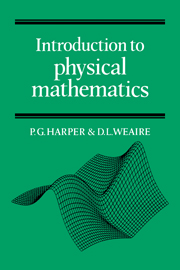Book contents
- Frontmatter
- Contents
- Preface
- Some notes on notation
- 1 Introduction
- 2 Errors
- 3 Cartesian coordinates
- 4 Vectors
- 5 The scalar product
- 6 The vector product and rotation
- 7 Matrices in physics
- 8 The transformation of matrices
- 9 The matrix eigenvalue equation
- 10 Exponential and logarithm functions
- 11 Sine and cosine functions
- 12 Graph plotting and curve sketching
- 13 Differentiation
- 14 Approximations
- 15 Power series and Taylor's expansion
- 16 Partial differentiation
- 17 Integration
- 18 The differential equation
- 19 Solving first-order differential equations
- 20 Second-order differential equations
- 21 Solving second-order differential equations
- 22 The complex exponential
- 23 The circuit equation
- 24 Harmonics and Fourier series
- 25 The diffusion equation
- 26 Waves
- 27 The rate of change of a vector
- 28 The scalar field and gradient operator
- 29 The vector field
- 30 Line integration
- 31 The potential field
- 32 Surface and volume integration
- 33 Flux and divergence
- 34 Circulation and the curl
- 35 Conclusion
- 36 Miscellaneous exercises
- Index
- Frontmatter
- Contents
- Preface
- Some notes on notation
- 1 Introduction
- 2 Errors
- 3 Cartesian coordinates
- 4 Vectors
- 5 The scalar product
- 6 The vector product and rotation
- 7 Matrices in physics
- 8 The transformation of matrices
- 9 The matrix eigenvalue equation
- 10 Exponential and logarithm functions
- 11 Sine and cosine functions
- 12 Graph plotting and curve sketching
- 13 Differentiation
- 14 Approximations
- 15 Power series and Taylor's expansion
- 16 Partial differentiation
- 17 Integration
- 18 The differential equation
- 19 Solving first-order differential equations
- 20 Second-order differential equations
- 21 Solving second-order differential equations
- 22 The complex exponential
- 23 The circuit equation
- 24 Harmonics and Fourier series
- 25 The diffusion equation
- 26 Waves
- 27 The rate of change of a vector
- 28 The scalar field and gradient operator
- 29 The vector field
- 30 Line integration
- 31 The potential field
- 32 Surface and volume integration
- 33 Flux and divergence
- 34 Circulation and the curl
- 35 Conclusion
- 36 Miscellaneous exercises
- Index
Summary
The theoretical side of physical science holds up a mathematical mirror to nature. It seeks to find in the infinite variety of physical phenomena the few basic laws and relationships which underlie them. A secondary goal is the expression of these relations in efficient and transparent language.
After Newton had shown the power of this method, the eighteenth and nineteenth centuries saw its steady advance, hand-in-hand with experiment. At the end of the nineteenth century there was a crisis in physics – a widening gulf between theory and experiment – but, when Einstein emerged to resolve it, the new physics was still based on the old mathematics. It was simply used in surprising new ways. So it remains today, to a large extent, whatever educational theorists may tell us. Newton would not be greatly puzzled by the mathematics of Schrödinger's Equation.
On the other hand, the rapid development of computers is certainly changing our attitude to mathematics. This is obvious in the case of straightforward numerical calculations, but it extends also to the simulation of complex systems, the manipulation of algebra and even the proving of theorems. Applied mathematics is the art of the possible, and computers have widened its scope enormously. They are not just ‘number-crunchers’. Nor are they available only to specialists. Most students today enjoy access to a powerful computer system, and many are skilled programmers at an early age.
- Type
- Chapter
- Information
- Introduction to Physical Mathematics , pp. vii - viiiPublisher: Cambridge University PressPrint publication year: 1985



